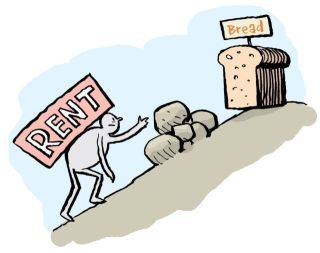Locked Out of the Market

Locked Out of the Market is a quarterly report published by the Simon Communities of Ireland based on a snapshot survey conducted over three consecutive days. This latest version published in January 2023, covers three days in December 2022 and uses data from Daft.ie (an Irish property website that lists the asking prices for properties to both rental and buy) to track the number of properties advertised to rent that fall within Housing Assistance Payment (HAP) limits.
They found there were just 757 properties available to rent at any price within 16 areas [1] over the three dates surveyed. This is almost twice as many as the 392 properties listed as available in the September 2022 report. However, it is a 44 per cent decrease from the same period in 2021 and a 56.8 per cent drop from the same period pre-pandemic in December 2019.
Properties concentrated in Dublin
508 (67 per cent) of all the available properties listed in December 2022 were in Dublin. Sligo Town and Portlaoise had only two properties listed as available to rent over the three day period of the study. Of the 16 areas studied, 14 of them showed an increase in the number of properties to rent apart from Cork City Suburbs and Portlaoise and notably the proportion of properties that would be affordable under the Housing Assistance Payment (HAP)[2] scheme was found to be low compared to previous Locked Out Reports. Dundalk and Kildare were the only areas outside of Dublin to have any properties listed that would be affordable under HAP rates.
11 of the 16 areas had no HAP properties available to rent for any HAP tenants (Athlone, Cork City Centre, Cork City Suburbs, Galway City Centre, Galway City Suburbs, Co. Leitrim, Limerick City Suburbs, Limerick City Centre, Sligo Town, Portlaoise, and Waterford).
All household types finding it difficult to secure accommodation
In this report, there was one property affordable under a standard HAP rate. This property was in Kildare, a one-bedroom suitable for a either a single person or a couple. Once the extra allowance of the discretionary rate was applied, an extra 40 properties were fell under the limit. Of these 40, 24 ( just over 58 per cent) were located within three Dublin areas which is most likely down to the fact that the discretionary rate in Dublin in 50 per cent instead of the 35 per cent allowed for the rest of the country.
For single persons and couples, eleven properties were available through HAP. Ten of these were only affordable once the discretionary rate was applied, only one fell under the standard HAP rate. Six were in the Dublin areas and the other five were found in Kildare.
For either a couple or a lone parent with one child, 23 properties were available within the discretionary HAP limits for families with one child, with only six of them found outside of Dublin.
For a couple or lone parent with two children, 30 properties were found for rent under the discretionary HAP rates, bearing in mind that 23 of these overlapped with those properties available to one-child families.
Social Housing, not Social Housing Supports
The Housing Assistance Payment is not delivering as a form of social housing support. It is not providing choice, security or affordability. The lack of availability means that either the tenant or Local Authority ends up paying more than expected, or allowed for, within their respective budgets. For those who cannot make up that difference, homelessness is the most likely outcome. The private rented sector is not the solution to a public housing crisis. In fact, a 2019 Report by Focus Ireland found that 70 per cent of families accessing emergency accommodation in Dublin in 2019 came from the private rented sector. [3] As the numbers of those having to access emergency and homeless accommodation, continues to rise, more needs to be done to ensure secure, sustainable, affordable housing is available to all.
Double Social Housing Stock by 2030
Other European countries which we would like to emulate have a social housing stock that is 20 per cent of their overall housing stock compared to 9 per cent in Ireland. The real need for social housing is under reported as those in HAP tenancies, DSGBV refuges, Direct Provision and many at risk of losing their home due to mortgage arrears are not included. We estimate the real numbers in housing need are closer to 133,000. To achieve the target of 20 per cent by 2030, Government must double its Housing for All targets at an additional cost of €1.4bn, meaning the overall construction budget would be closer to €3bn in 2023. This investment will require a skilled workforce. Inclusion of a new construction apprenticeship programme whereby one in every fifteen is required to be an apprentice earning at least the Living Wage must form part of any rebuilding scheme. This would also result in an additional 60,000 properties, currently being used as social housing, entering the private rented sector for use by private tenants.
[1] Cork City Centre, Cork City Suburbs, Dublin City Centre, Dublin City North, Dublin City South, Galway City Centre, Galway City suburbs, Limerick City Centre, Limerick City suburbs, Portlaoise, Kildare (selected areas), Athlone, Sligo Town, Dundalk, Co. Leitrim, and Waterford City Centre.
[2] https://hap.ie/howdoeshapwork/
[3] https://www.focusireland.ie/press-releases/